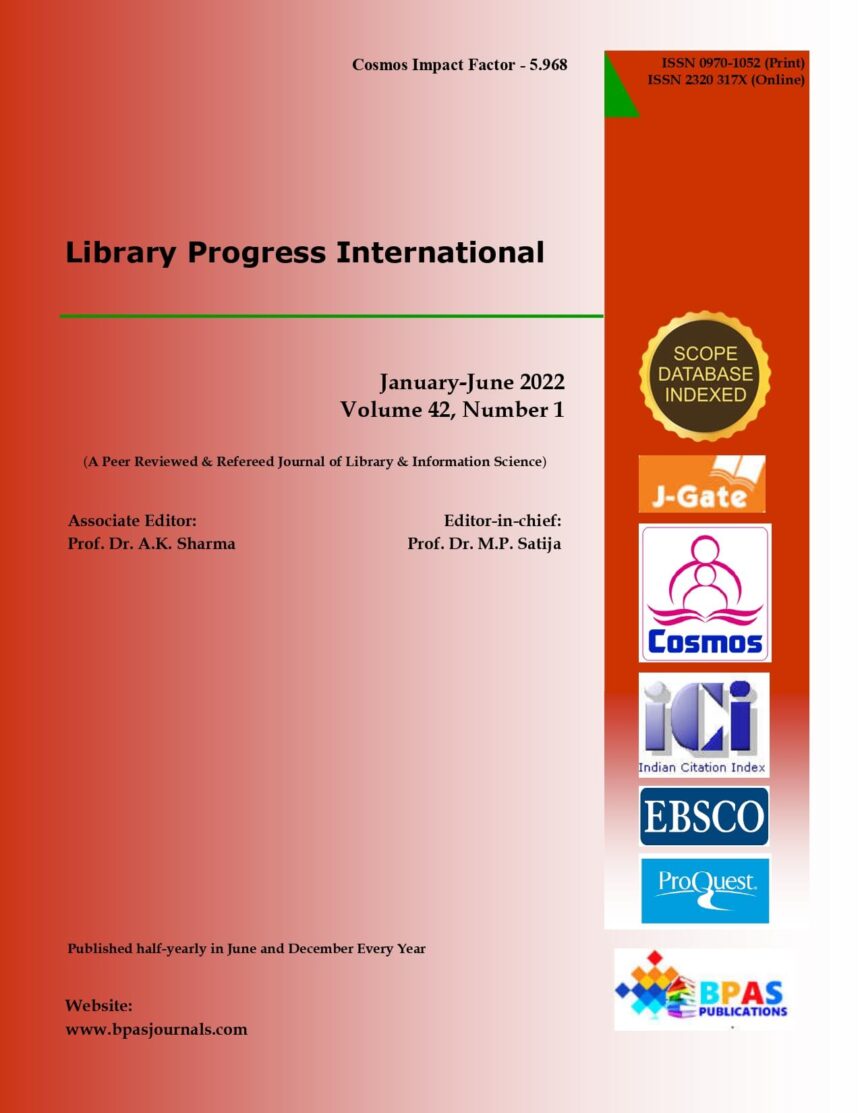Overview of Security Measures in Nigerian University Libraries
DOI:
https://doi.org/10.48165/Keywords:
Security Measures, Theft, Library Materials, Libraries, Library Management, Library UsersAbstract
The paper takes a look at the incidence of mutilation and theft and of library materials, and gives users’ assessment of library security and factors that influence mutilation and theft among library users in Nigerian university libraries. Librarians all over the world are increasingly disturbed with the safety and physical integrity of important intellectual properties. Periodical and reference materials are the most likely materials that will be mutilated. All of the libraries still rely exclusively on manual checks carried out by unskilled personnel at the library exit and entrance. The high cost of photocopying and frequent breakdown of copiers was the causes of library material theft and mutilation. The results show that all the university libraries stamps specific pages, with security personnel and porters are at the entrance door of the libraries checking in and checking out users of the library. Findings from the study revealed that university libraries in Nigeria must adopt security measures to prevent theft of library materials. Therefore, media centers and libraries must adopt security measures to protect the software and hardware from serious harm. The paper wrap up by offering some constructive suggestions on the way out of these problems.
Downloads
References
Abioye, A. and Adeow , O. F. (2013) Security Risks Management in Selected Academic 2. Adewuyi, O.W. and Adekanye, E.A. (2011). Strategy for prevention of crime in Nigerian university libraries: The experience of the University of Lagos. Library and Archival Security 24 (1). Available at: http://www.tandf.co.uk/journals/titles/01960075.asp Ajala, I.O and Onyeboade, S.A. (2008). Theft and mutilation of library materials in
Ajayi, N. A., & Omotayo, B. O. (2004). Mutilation and theft of library materials: Perceptions and reactions of Nigerian students. Information Development, 20(1), 61-66.
Ajegbomogun, F.O. (2004). Users’ assessment of library security: a Nigerian university case study. Library Management. 25(8/9): 386-390.
Akinfolarin, W. A. (1992).Towards improved security measures in Nigeria university libraries. 6. Akinwumi, K. (1984). What is academic library and the role of academic libraries? Niger 7. Akussah, H. (2006).The state of document deterioration in the National Archives of Ghana. 8. Akussah, H. and Bentil W. (2010). Abuse of library materials in academic libraries: A study a
library.html and Information Science 20 (2): 103-112. And Research Libraries 42: 341-346 print ISSN: 2059-9056, Online ISSN: 2059-9064
Aziagba, P. C., & Edet, G. T. (2008).Disaster-control planning for academic libraries in West Africa. The Journal of Academic Librarianship 34 (3), 265-268.
Bello, M.A. (1998). Library Security: Material theft and mutilation in technological university libraries in Nigeria. Library Management 19 (6):378 – 383.
Bello, M.A. (1998). Library security: Material theft and mutilation in technological university libraries in Nigeria. Library Management 19 (6): 378-383.
Broadhead, R.M. (2002). Theft in Academic libraries. New York: New Library World. 13. Emojorho, D. (2012) loss of library material in Delta state University library, Abraka-Nigeria. 14. Esarbica region. African Journal of Library, Archives and Information Science, 15(1), 19. 15. Isebe, I.E.M. (2014). Cause and effects of theft and mutilation of information materials in academic
library services in delta state. Journal of Information Knowledge and Management. 4(10) 76-82. Available at http//www. iiste.org.
Ives, D.J. (1996).Security management strategy for protecting your library’s network. Computer in Libraries 16 (2)
Jato, Michael. (2005). Causes and effect of delinquent behaviour in academic libraries: A case 18. Maidabino, A. A. (2010). Collection security issues in Malaysian academic libraries: An 19. Maidabino, A.A. (2010). Collection security issues in Malaysian academic libraries: an exploratory
survey. Library Philosophy and Practice. Available: http://unllib.unl.edu/LPP/maidabino.htm 20. Mansfield, D. (2009).Reducing book theft at university libraries. Journal of Library and 21. Martell, C. (2010).Theft and its effects on our neighborhood libraries. Public Library Quarterly 29 (1). Doi:10.1080/01616840903562943.
Matthew, Graham. (2004). Preservation and management: Sources of information. In John 23. McComb, M. (2004).Library security. San Francisco: RLS Inc.
McComb, Mark. (2004).Library Security. Retrieved 23 May 2011 from: http://www.librisdesign.org/docs/LibrarySecurity.pdf
Momodu, M. A. (2002).Delinquent readership in selected urban Libraries in Nigeria. Library 26. Momodu, M.A. (2002).Delinquent readership in selected urban libraries in Nigeria. Library 27. Ngulube, Patrick. (2005). Disaster and security management in public archival institutions in 28. Nielsen, E. (2002). Library security management: An introduction. Liber Quarterly 12: 293 29. Obafemi Awolowo University, Ile-Ife. Nigerian Libraries, 39, 65-78. of the University of Cape Coast main library. African Journal on Librarianship, Archival
Okoye, C.O.(2000).Preservation of library materials. Enugu: Bizeduco Int. publisher 31. Okwilagwe, O. A. (2008).Reference sources and services.An Unpublished Lecture Note. 32. Olanlokun, S. O. (2000). Library security: The library manager’s perspective. Lagos Librarian, 33. Omoniyi, J. O. (2001). The security of computer and other electronic installations in university
Omotayo, B. O.; &Ajayi, N. A. (2006). An appraisal of security measures in Hezekiah library, 35. Osayande, Odaro. (2009). Security issues in academic libraries: The way out. Journal of Library and Information Science, 6(1).
PNLA Quarterly 77:2 (Winter 2013)Security Practices in Nigerian University Libraries, 37. Rajendran, L., & Rathinasabapathy, G. (2007). Role of electronic surveillance and security

